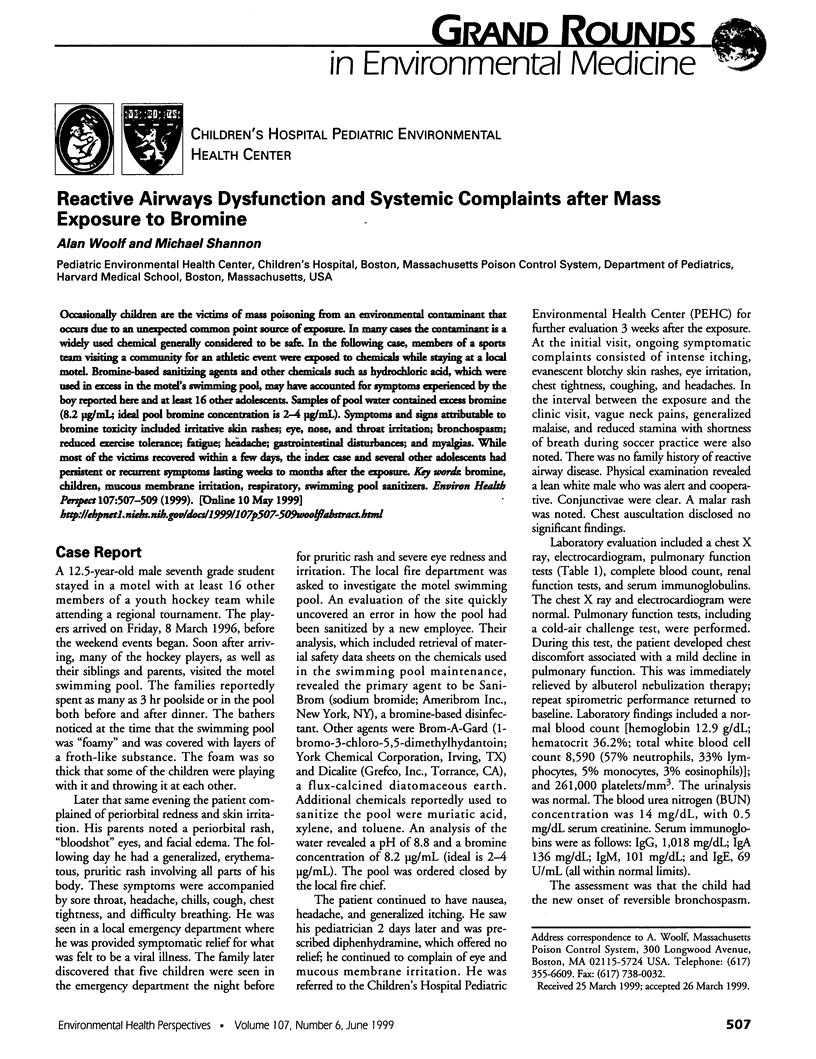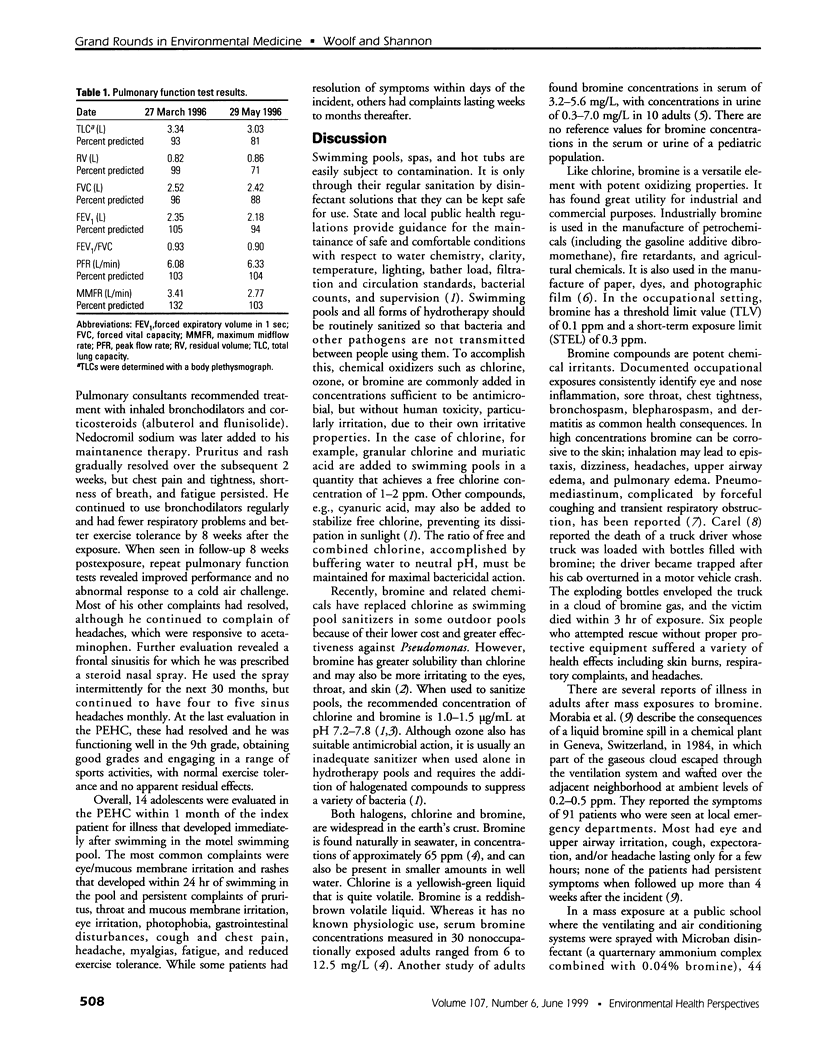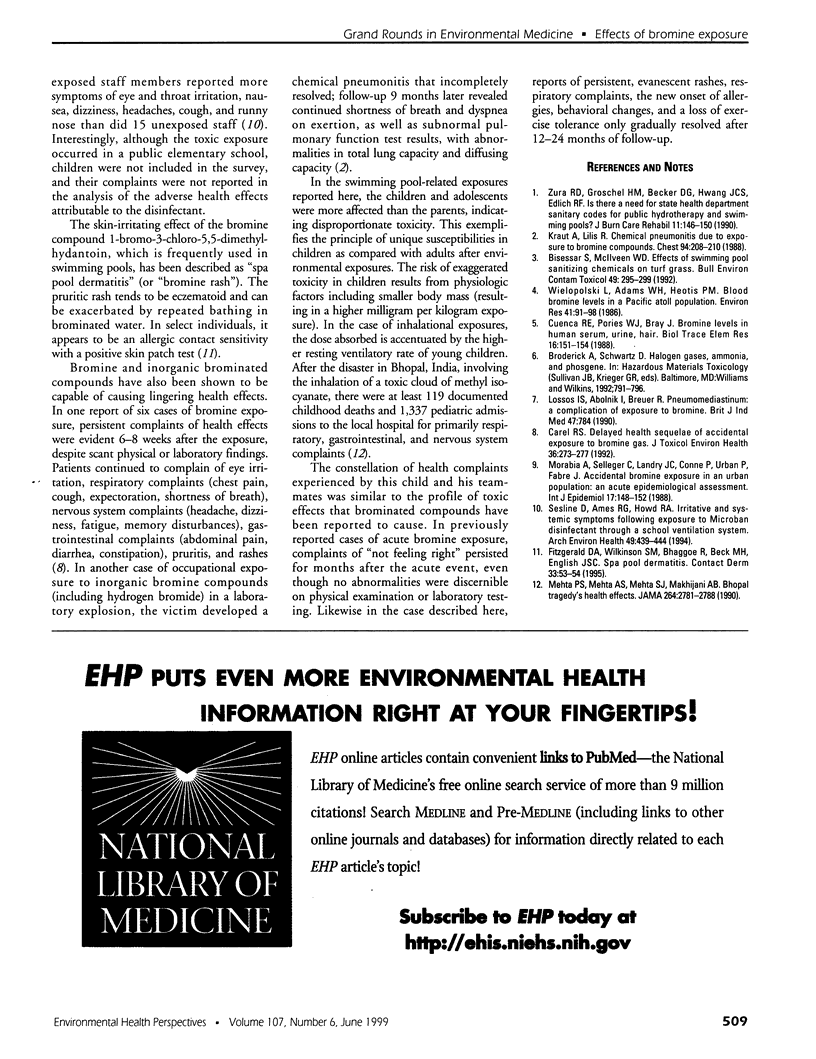Abstract
Occasionally children are the victims of mass poisoning from an environmental contaminant that occurs due to an unexpected common point source of exposure. In many cases the contaminant is a widely used chemical generally considered to be safe. In the following case, members of a sports team visiting a community for an athletic event were exposed to chemicals while staying at a local motel. Bromine-based sanitizing agents and other chemicals such as hydrochloric acid, which were used in excess in the motel's swimming pool, may have accounted for symptoms experienced by the boy reported here and at least 16 other adolescents. Samples of pool water contained excess bromine (8.2 microg/mL; ideal pool bromine concentration is 2-4 microg/mL). Symptoms and signs attributable to bromine toxicity included irritative skin rashes; eye, nose, and throat irritation; bronchospasm; reduced exercise tolerance; fatigue; headache; gastrointestinal disturbances; and myalgias. While most of the victims recovered within a few days, the index case and several other adolescents had persistent or recurrent symptoms lasting weeks to months after the exposure.
Full text
PDF


Selected References
These references are in PubMed. This may not be the complete list of references from this article.
- Bisessar S., McIlveen W. D. Effects of swimming pool sanitizing chemicals on turf grass. Bull Environ Contam Toxicol. 1992 Aug;49(2):295–299. doi: 10.1007/BF00191770. [DOI] [PubMed] [Google Scholar]
- Carel R. S., Belmaker I., Potashnik G., Levine M., Blau R. Delayed health sequelae of accidental exposure to bromine gas. J Toxicol Environ Health. 1992 Jul;36(3):273–277. doi: 10.1080/15287399209531637. [DOI] [PubMed] [Google Scholar]
- Cuenca R. E., Pories W. J., Bray J. Bromine levels in human serum, urine, hair. Short communication. Biol Trace Elem Res. 1988 Jul;16(2):151–154. doi: 10.1007/BF02797099. [DOI] [PubMed] [Google Scholar]
- Fitzgerald D. A., Wilkinson S. M., Bhaggoe R., Beck M. H., English J. S. Spa pool dermatitis. Contact Dermatitis. 1995 Jul;33(1):53–53. doi: 10.1111/j.1600-0536.1995.tb00451.x. [DOI] [PubMed] [Google Scholar]
- Kraut A., Lilis R. Chemical pneumonitis due to exposure to bromine compounds. Chest. 1988 Jul;94(1):208–210. doi: 10.1378/chest.94.1.208. [DOI] [PubMed] [Google Scholar]
- Lossos I. S., Abolnik I., Breuer R. Pneumomediastinum: a complication of exposure to bromine. Br J Ind Med. 1990 Nov;47(11):784–784. doi: 10.1136/oem.47.11.784. [DOI] [PMC free article] [PubMed] [Google Scholar]
- Mehta P. S., Mehta A. S., Mehta S. J., Makhijani A. B. Bhopal tragedy's health effects. A review of methyl isocyanate toxicity. JAMA. 1990 Dec 5;264(21):2781–2787. [PubMed] [Google Scholar]
- Morabia A., Selleger C., Landry J. C., Conne P., Urban P., Fabre J. Accidental bromine exposure in an urban population: an acute epidemiological assessment. Int J Epidemiol. 1988 Mar;17(1):148–152. doi: 10.1093/ije/17.1.148. [DOI] [PubMed] [Google Scholar]
- Sesline D., Ames R. G., Howd R. A. Irritative and systemic symptoms following exposure to Microban disinfectant through a school ventilation system. Arch Environ Health. 1994 Nov-Dec;49(6):439–444. doi: 10.1080/00039896.1994.9954998. [DOI] [PubMed] [Google Scholar]
- Wielopolski L., Adams W. H., Heotis P. M. Blood bromine levels in a Pacific atoll population. Environ Res. 1986 Oct;41(1):91–98. doi: 10.1016/s0013-9351(86)80171-2. [DOI] [PubMed] [Google Scholar]
- Zura R. D., Gröschel D. H., Becker D. G., Hwang J. C., Edlich R. F. Is there a need for state health department sanitary codes for public hydrotherapy and swimming pools? J Burn Care Rehabil. 1990 Mar-Apr;11(2):146–150. doi: 10.1097/00004630-199003000-00011. [DOI] [PubMed] [Google Scholar]


